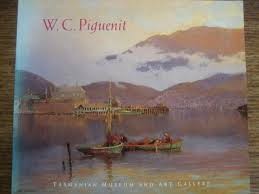First Edition, pp. 112 colour and b&w illusts, #0518
One of the earliest professional painters born in Australia, William Charles Piguenit was mainly self-taught, drawing his inspiration from European romanticism with an emphasis on motifs of heavy grandeur. Known for his Tasmanian landscapes, Piguenit’s paintings portray nature in terms of its infinite mystery combined with a topographical essence of its features, and are related to the work of émigré Australian artists, Eugene von Guérard and Nicholas Chevalier.
Son of a convict transported to Van Diemen’s Land in 1830, William Charles Piguenit was born in Hobart, Tasmania, in 1836. He worked in the Tasmanian Lands and Survey Department from 1850 as a draughtsman and mapmaker, where he learned lithography from Frank Dunnett and Robin Vaughan Hood and developed an interest in photography. After leaving the survey office in 1872, he began making sketching and photography trips to remote and spectacular regions in Tasmania, including Lake St Clair in 1873. He exhibited photographs and paintings of wilderness scenes throughout the 1870s.
Piguenit moved to Sydney in 1880, settling in Hunter’s Hill with his family and travelling extensively in search of landscape subjects. He achieved early success through public patronage, regularly exhibited paintings in Tasmania and mainland Australia, and joined art societies in Sydney, Melbourne, and Auckland. His striking landscape Mount Olympus, Lake St Clair, Tasmania, source of the Derwent 1875 was the first oil painting by an Australian-born artist to be acquired through public subscription by the newly formed Art Gallery of New South Wales in 1875. Evoking a sublime majesty through a masterful orchestration of earth, water and sky, Piguenit departed from earlier colonial artists in such works by placing an emphasis on atmospheric conditions of mist and clouds that enhanced the drama of his subjects.
That same year, Piguenit joined an artists’ and photographers’ camp in the Grose Valley in the Blue Mountains. Continued patronage by the Gallery enabled him to tour New South Wales and Tasmania, providing fresh inspiration for his grand, sweeping landscapes and measured studies of the natural environment for which he often relied on photographs as references. Recalling his earlier Tasmanian compositions, The Upper Nepean 1889 presents a pristine riverscape obscured by mist in which two men scurrying round rocks in the middle ground exude a sense of dwarfed human agency in the face of an overpowering nature. Indebted to 19th-century German romantic painting, the work also displays a sense of curiosity and awe that typifies Australian landscape art preceding the first consolidation of a national school in the later 1880s.
In 1895, Piguenit painted the grand history painting The flood in the Darling 1890 1895, one of several ambitious canvases produced in response to the devastating rains that inundated the western region of New South Wales that year. The largest flood recorded since 1864, waters broke the embankment and submerged the remote township of Bourke – an event Piguenit witnessed firsthand. However, rather than depicting the destroyed buildings, railway lines and loss of human life and livestock, he focuses on the calm after the deluge, presenting a symphonic celebration of sky, land and water with ibises the only living creatures populating the tranquil scene. A review in the Sydney Morning Herald described the landscape as ‘full of poetry’, highlighting in particular the ‘long line of melancholy silver light, which forms the horizon across nearly the entire canvas’ and ‘the beautiful foreground of water and waving reeds’.
Visiting England and Wales in 1898 and 1900, Piguenit continued to paint well into the 20th century. In 1903 he completed the commanding mountainous landscape Kosciusko, commissioned by the trustees of the Art Gallery of New South Wales. In his majestic depiction of the continent’s highest peak, he transforms the wilderness landscape into a national subject evoking the enormity of the Federation of Australia in 1901.
Piguenit’s landscapes were included in the exhibition 100 Years of Australian Painting, held at the Art Gallery of New South Wales in 1948, and featured in the 1993 touring exhibition, W.C. Piguenit 1836-1914.
